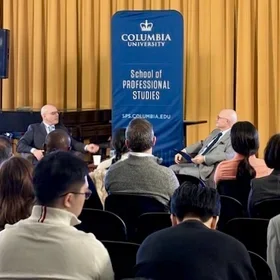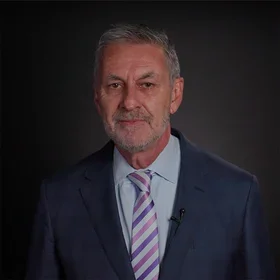On October 25, faculty and cofounders of Columbia’s Narrative Medicine program hosted a special event for the curators and designers participating in the sixth annual Designing for Empathy Summit. The theory and practice session included a presentation, conversation, and workshop that introduced attendees to the principles and methods of narrative medicine in both clinical and nonclinical settings.
The event featured talks by Dr. Danielle Spencer, senior lecturer in Columbia’s Master of Science in Narrative Medicine program, and Dr. Craig Irvine, codirector of the CUIMC Division of Narrative Medicine program, who also led the group in a hands-on demonstration of narrative close reading and freewriting.
Addressing a Profound Disconnect in Health Care
After welcoming the speakers and delegates, Louise Rosen, senior associate dean of Administrative Affairs and Communications at SPS, lecturer at SIPA, and a student in the Narrative Medicine program, shared a brief overview of the field of narrative medicine, which was founded at Columbia University in 2000 by Dr. Rita Charon as a way for medical practitioners, patients, and scholars to adopt the methods and values of narrative understanding to provide more effective and empathic care.
Charon’s interest in narrative medicine, Rosen explained, stemmed in part from her realization that “there was a profound disconnect in the way that doctors understood their patients and their experiences.”
In 2009, Columbia University School of Professional Studies’ Master of Science in Narrative Medicine became the first graduate program of its kind, offering students an opportunity to study the principles and practices of narrative medicine and explore new areas of theory and application with leading scholars in the field.
What Does It Mean to Offer Attention?
Dr. Danielle Spencer delved into the history, theory, and methodologies of narrative medicine, which utilizes familiar tools and strategies from the study and appreciation of artistic works—including the practices of close reading, deep listening, and concentrated witnessing—with the aim of fostering greater empathy between patients and clinicians.
“We all know that there is indeed a great deal of alienation in health care today, and a lack of affiliation and a lack of opportunities for human encounters,” Spencer said. “Narrative medicine is one means of trying to address that.”
In part, narrative medicine aims to diminish this sense of alienation by focusing attention on patients’ experiences and the way they tell their stories. “What does it mean to offer attention, whether it’s to another human being or to a poem or to a photograph? What does the receiver do? If you have a doctor who’s listening to an individual telling about an experience, what form of attention might one expect or wish for in that interaction?”
In the end, it’s not enough for the clinician to attend “just to the data that she is able to extract from a given patient in a given encounter,” Spencer said. “She must also attend to the form and structure of the story that is offered to her.”
Escaping the Straitjacket of Self
Next, Dr. Craig Irvine wove together case studies from his professional experience with philosophical reflections on the interconnected relationship between the stories we tell and our individual sense of purpose and identity.
“Stories are the primordial means through which we make sense of and convey the meaning of our lives,” he said. “It is this that the philosopher Paul Ricoeur points to when he speaks of ‘life as an activity and a passion in search of a narrative.’”
“Narrative medicine is medicine practiced with the competence to enter stories, move through them, and understand how they work, how they create identity,” he explained. One of the ways to achieve this is through the practice of close reading, which develops the skills necessary to understand the “complexity and ambiguity of human life and opens new possibilities of thinking.”
Irvine described the ways in which entering unfamiliar narrative worlds offers us the chance to temporarily inhabit someone else’s reality and thereby gain new insights that may expand both our minds and our empathic relations. Or as the novelist Richard Powers eloquently expressed it: “Shared stories are the only way anyone has for escaping the straitjacket of self.”
Shared Scenes of Care
The event culminated in an interactive workshop in two parts. First, Irvine led a demonstration of close reading, asking attendees to home in on the subtle yet profound choices of imagery, diction, and metaphor in the opening pages of Michael Ondaatje’s The English Patient.
This was followed by a short writing exercise in which attendees were prompted to write about “a scene of care” of their choosing. Several people, including Organization of Networks for Empathy founding president Elif Gokcigdem, shared their freewrites in what became an increasingly emotional workshop. “I never really shared this with anyone in this way,” Gokcigdem said. “Even with myself.”
About the Program
Columbia University’s Master of Science in Narrative Medicine prepares health professionals, writers, and scholars to apply the skills and values of narrative understanding to improve outcomes for both patients and caregivers. It offers a rigorous and in-depth study of close reading of creative texts, illness and disability narratives, narrative ethics, philosophy, creative writing, and other perspectives.


